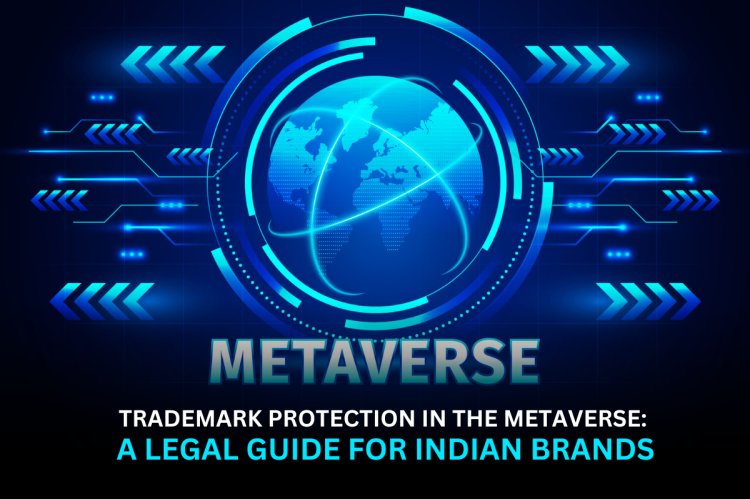Trademark Protection in the Metaverse: A Legal Guide for Indian Brands
Explore how Indian businesses can safeguard trademarks in the metaverse. This guide covers legal strategies, virtual goods registration, blockchain enforcement, and best practices for protecting digital assets in immersive virtual spaces.

Introduction
As brands increasingly expand their presence into virtual worlds, the metaverse presents both unprecedented opportunities and complex challenges for trademark protection. In today’s immersive digital spaces, elements like virtual goods, avatars, and NFTs (non-fungible tokens) have become key drivers of both commercial activity and personal identity.This blog explores how businesses, especially in India, can safeguard their trademarks in the metaverse, highlighting legal strategies, technological tools, and emerging best practices.
Why Trademark Protection Matters in the Metaverse
Trademarks are essential for distinguishing a brand’s products and services, both in the physical world and online. In the metaverse, where users interact, transact, and express themselves through digital avatars and assets, trademarks play a crucial role in maintaining brand integrity, preventing confusion, and combating counterfeiting.
The decentralized and global nature of the metaverse means that unauthorized use of trademarks can occur across multiple platforms simultaneously, making enforcement more challenging than in traditional digital spaces. Therefore, businesses aiming to build and safeguard their brand in the digital space must adopt forward-thinking and flexible trademark strategies.
Trademark Protection Tactics for the Virtual World
1. Secure Trademark Protection for Digital Products and Virtual Services
The foundation of metaverse trademark protection is registration. Companies need to revise their trademark portfolios to clearly include protection for virtual products and digital services. For example, global brands like Nike, Gucci, and Adidas have filed trademark applications for downloadable virtual goods, including shoes, apparel, and accessories.
Indian Context:
India’s trademark registration system, established under the Trade Marks Act, 1999, offers broad protection across numerous sectors. Although the legislation doesn’t specifically reference virtual goods or NFTs, businesses can still safeguard their digital brand presence by registering under appropriate classes including Class 9 for software and virtual goods, Class 35 for e-commerce and digital retail services, and Class 41 for online educational and entertainment content..
Steps for Registration:
- Identify the Appropriate Class: Use the Nice Classification system to select relevant classes for digital assets.
· Perform a Trademark Availability Check: Verify that your mark isn’t already in use within metaverse platforms or NFT ecosystems to avoid conflicts.
· Submit a Precise Application: Clearly outline the intended use of the trademark in virtual environments when filing for registration.
· Watch and Protect Your Brand: Regularly keep an eye on digital marketplaces and NFT platforms to identify and address any unauthorized use of your mark.
.
2. Monitor and Enforce Trademark Use Across Virtual Platforms
In the fast-changing landscape of the metaverse, constant and proactive monitoring is essential.Companies should use a combination of technological tools and legal expertise to detect unauthorized use of their trademarks.
Indian Context:
Section 29 of the Trade Marks Act, 1999 addresses trademark infringement, protecting goods and services within their registered class. If a user creates virtual merchandise resembling a popular Indian brand’s products without permission, this could constitute trademark infringement. The brand has the option to pursue legal action to stop misuse and safeguard its public image.
Tools and Practices:
- AI-Driven Surveillance: Advanced artificial intelligence and machine learning technologies can track potential trademark violations across virtual worlds, social platforms, and NFT exchanges.
- Brand Protection Tools: Many platforms offer built-in brand protection features, but third-party monitoring services may be necessary for comprehensive coverage.
- Legal Action: When infringement is detected, businesses should act swiftly—issuing cease and desist letters, filing takedown requests, or pursuing litigation if necessary.
3. Leverage Blockchain and Smart Contracts
Blockchain technology is transforming trademark enforcement in the metaverse by providing immutable, verifiable records of ownership and transactions.
Indian Context:
Smart contracts and blockchain are increasingly used for transparency and automation. However, while the Indian Contract Act, 1872, provides the foundational framework for contracts, it may not comprehensively capture the complexities of agreements formed in digital environments.Further legal clarification is needed for enforceability, liability, and dispute resolution in the context of smart contracts.
Applications:
- Immutable Ownership Records: Registering trademarks on the blockchain creates a tamper-proof record for legal disputes.
- Smart Contracts for Licensing: Automate licensing agreements to ensure only authorized parties use branded digital assets.
- NFT Authentication: Linking trademarks to NFTs helps authenticate digital goods and prevent counterfeiting.
To know more about this you can follow the link below:
4. Develop Robust Terms of Service and Governance Agreements
To reinforce trademark rights, businesses should implement strong terms of service agreements for their digital assets and branded virtual spaces.
Indian Context: Developers of metaverse platforms and brand stakeholders should embed strong trademark protection provisions within their Terms of Service agreements. Licensing laws under Section 49 of the Trade Marks Act, 1999, allow for permitted use agreements, which are essential for virtual environments.
Best Practices:
- Usage Guidelines: Clearly define how trademarks may be used within the metaverse.
- Collaboration with Platforms: Work closely with metaverse platforms to establish clear policies for reporting and removing infringing content.
- Engaging in Decentralized Governance: Contribute to the policy-making processes of decentralized platforms to support the development of IP rights protection frameworks.
5. Educate Consumers and Build Brand Awareness
Consumer education is a powerful tool for preventing fraud and confusion in the metaverse.
Indian Context:
As the metaverse gains traction in India, educating consumers about authentic digital goods and official brand channels is crucial to prevent fraud and brand dilution.
Strategies:
- Official Brand Presence: Clearly communicate your brand’s official presence in virtual worlds.
- Ensuring Authenticity: Leverage blockchain technology and digital certificates to offer verifiable proof of ownership and genuineness for branded virtual assets.
Emerging Technologies and Future Trends
The metaverse is evolving rapidly, driven by advances in artificial intelligence, blockchain, and decentralized finance (DeFi).
Indian Context:
Indian brands are actively joining the global movement to establish trademark rights in the metaverse. An examination of the Trade Marks Registry’s online records shows that multiple entities have successfully secured registrations for the term ‘METAVERSE’ across different trademark classes. Additionally, a growing number of applications for METAVERSE-based marks and designs are either approved or awaiting registration..
Key Trends:
· Artificial Intelligence and Machine Learning: Crucial tools for tracking and protecting trademarks across expansive digital and virtual landscapes
- Virtual Real Estate: Protecting trademarks in digital properties is essential to prevent squatters and infringers.
- Decentralized Enforcement: The rise of decentralized autonomous organizations (DAOs) and community-driven governance is reshaping how intellectual property is managed and enforced in the metaverse.
Case Studies: Global and Indian Brands
- Global Brands: Nike, Gucci, and Adidas have set precedents by securing trademarks for downloadable virtual goods and launching branded virtual spaces.
- Indian Brands: Companies such as Reliance, Infosys, and others are beginning to explore the metaverse, with some already registering trademarks for digital goods and services. For instance, Reliance has registered the ‘AJIO LUXE’ brand under Class 9, which covers digital platforms and potentially virtual goods.
Best Practices for Indian Businesses
- Stay Informed: Keep up to date with new metaverse platforms, technologies, and legal developments.
- Be Proactive: Regularly review and update your trademark strategy to address emerging risks and opportunities.
- Collaborate: Work with legal experts, technology providers, and metaverse platforms to ensure comprehensive protection.
Conclusion
Navigating trademark protection for digital assets in the metaverse requires a forward-looking, multi-faceted approach. By registering trademarks for virtual goods, leveraging advanced technologies like blockchain and AI, and collaborating with platforms and communities, Indian businesses can safeguard their brands and thrive in the new digital frontier. As the legal landscape evolves, proactive strategies and robust enforcement will be key to maintaining brand integrity and unlocking the full potential of the metaverse in India.












